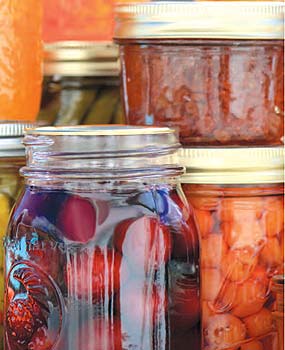Yes, you can!
Preserve the season’s bounty
to enjoy year-round.
WRITTEN BY SHELLEY BRANT
PHOTO BY JACI GOODMAN
A few years ago, the concept of canning or preserving food was rarely mentioned in my social circles. Now, with the increased interest in reconnecting with real food, learning to can food is on many wish lists. Canning is a science and an art but one that anybody can master. There is one glitch. How do we learn this skill when many of us are at least one generation removed from relatives who routinely put-up some or all of their own food?
If you’re lucky you know an experienced canner who will pass along their knowledge or you can sign up for canning workshops periodically presented around town by places such as River School in Reno. You also can teach yourself using online resources or theWashoe County Library System and its canning section (641.4).
My husband and I have been putting up food for the last three seasons and now feel pretty confident in our skills and methods. Here’s what we’ve learned:
FOLLOW DIRECTIONS
Find reliable books to learn from and resist the temptation to alter the recipe ingredients or take processing shortcuts. Canning food is serious business and food safety is important. Follow the directions exactly and pay attention to the high-altitude instructions that apply to our region.
CHOOSE FRESH
Buy or pick the freshest produce and can it as soon as possible. If you can’t put it up right away, place the freshly washed and dried produce in the freezer, and then defrost and preserve it later. This works well for tomatoes because freezing causes the skin to come off easily. That way you can skip the blanching and peeling step.
KEEP IT COOL
Canning produces a lot of heat, which isn’t necessarily desirable in hot months. Freeze your fresh produce and can it when the weather cools.
MAKE IT EASY
Many of the foods my family puts up are well suited to the water-bath canning method. It is less expensive and easier to master than pressure canning.
GO SMALL
Putting up smaller batches of a wide variety of prepared foods, such as lemon-cucumber pickles, salsas, and tapenades, is more manageable than big batches of one food. Small-batch canning works really well with the quantities grown in a backyard garden, and it creates a more varied food palette in your pantry. I pack a lunch for work and love being able to reach into my pantry for a small jar of Madras Pickled Eggplant to combine with some bread or crackers, a wedge of cheese, and fruit. Voilà! Tasty lunch packed in a hurry.
CAN TOMATOES
One food we put up in bulk every year is tomatoes, about 80 pounds. When it’s cold outside we love to eat stews, soups, and pastas. And two of us, along with our frequent guests, go through every can before fresh tomato season arrives. Local farmers are happy to sell in bulk and some will bring your order to the farmers’ market for pick-up. Call them first to make arrangements.
SHARE YOUR WARES
Make extra jars of your favorite recipes to share. People love homemade food and little jars of something tasty make perfect gifts. This year ½ cup-sized canning jars showed up at Ace Hardware, a perfect size for sharing.
Share the experience with your family and friends. Invite people over to cut, chat, can, and then share the bounty. You’ll get to spend some time with people you care about, share what you learn, and increase the variety in your pantry.
Canning food takes time and care, but what a great way to connect with your food, family, and community. Use the resources on page 37 to help you on your way.
LEARN TO CAN
Ball Blue Book of Preserving
Joy of Cooking: All About Canning and Preserving, by Irma S. Rombauer, Marion Rombauer Becker, and Ethan Becker
More books are available from the Washoe County Library System at Washoecounty.us/library and Sundance Bookstore at Sundancebookstore.com.
National Center for Home Food Preservation at Uga.edu/nchfp
River School: www.Riverschool.info
El Dorado County University of California Cooperative Extension Master Preservers program: Ceplacer.ucdavis.edu
LOCAL FARMS THAT SELL IN BULK
Lattin Farms • Lattinfarms.com • 775-867-3750
Workman Farms • 775-867-3716
FAVORITE RECIPE BOOKS
Ball Complete Book of Home Preserving, edited by Judi Kingry and Lauren Devine
Complete Book of Small-Batch Preserving, by Ellie Topp and Margaret Howard
Well-Preserved: Recipes and Techniques for Putting Up Small Batches of Seasonal Foods, by Eugenia Bone
Shelley Brant has been a locavore and local food advocate since 2006. Her search for local food led to the development of Local Food Northern Nevada (Lfnn.blogspot.com), a blog for others looking to bring locally grown food to their families. Learning to preserve food came as a natural result of wanting to eat locally grown food throughout the cold season.


